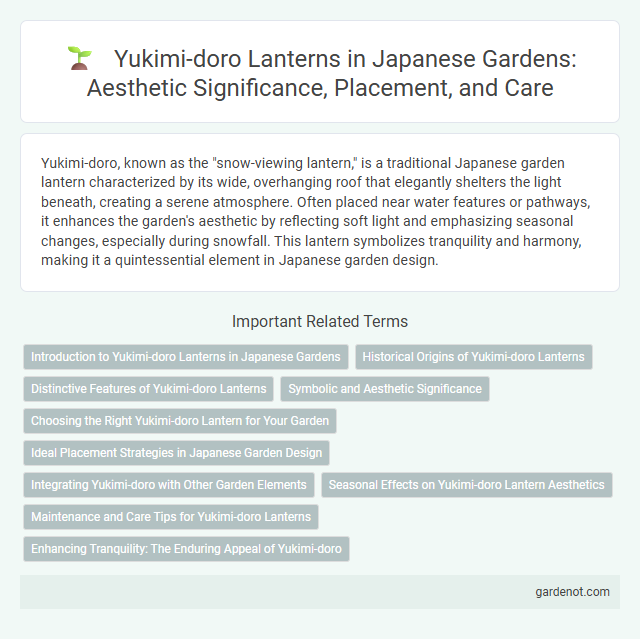Yukimi-doro, known as the "snow-viewing lantern," is a traditional Japanese garden lantern characterized by its wide, overhanging roof that elegantly shelters the light beneath, creating a serene atmosphere. Often placed near water features or pathways, it enhances the garden's aesthetic by reflecting soft light and emphasizing seasonal changes, especially during snowfall. This lantern symbolizes tranquility and harmony, making it a quintessential element in Japanese garden design.
Introduction to Yukimi-doro Lanterns in Japanese Gardens
Yukimi-doro lanterns, also known as "snow-viewing lanterns," are a distinctive feature in Japanese gardens, characterized by their wide, overhanging roofs designed to catch falling snow. These stone lanterns typically consist of a three-legged base symbolizing stability, a pedestal, a light chamber, and a broad roof that provides a serene, aesthetic appeal during winter. Originating from the Edo period, Yukimi-doro lanterns enhance garden tranquility by blending functional illumination with seasonal beauty.
Historical Origins of Yukimi-doro Lanterns
Yukimi-doro lanterns, also known as "snow-viewing lanterns," originated during Japan's Edo period, reflecting the aesthetic principles of traditional Japanese garden design. These lanterns were designed with wide, flat roofs to catch and display snow, symbolizing seasonal beauty and tranquility. Their historical significance lies in enhancing garden landscapes by blending functionality with poetic visual appeal, creating a serene atmosphere that echoes Japanese cultural values.
Distinctive Features of Yukimi-doro Lanterns
Yukimi-doro lanterns feature broad, umbrella-like roofs that elegantly curve outward, providing both aesthetic appeal and protection from rain. Their sturdy stone legs typically extend into a pond or water feature, creating reflections that enhance the tranquil atmosphere. These lanterns are distinctively designed to be viewed up close, emphasizing their harmonious integration with surrounding natural elements in traditional Japanese gardens.
Symbolic and Aesthetic Significance
Yukimi-doro stone lanterns, often called "snow-viewing lanterns," embody the harmony between nature and human craftsmanship in traditional Japanese gardens. Their wide, umbrella-like roofs symbolize protection and meditation, while the lantern's placement near water reflects the garden's aesthetic principle of balance and tranquility. These lanterns enhance the serene ambiance, serving both as functional light sources and elegant sculptural elements that invite contemplation and seasonal appreciation.
Choosing the Right Yukimi-doro Lantern for Your Garden
Selecting the ideal Yukimi-doro lantern for your Japanese garden involves considering its size, material, and placement to complement the garden's aesthetic. Stone lanterns crafted from granite or natural stone offer durability and authenticity, while their tiered roofs and broad bases provide balanced illumination and visual appeal. Positioning the lantern near water features or pathways enhances tranquility and highlights key garden elements during evening hours.
Ideal Placement Strategies in Japanese Garden Design
Yukimi-doro, or "snow-viewing lanterns," are ideally placed near water features or lush greenery in Japanese garden design to enhance their reflective beauty and seasonal appeal. Positioning these stone lanterns at garden edges or beside ponds creates tranquil focal points that harmonize with natural surroundings and invite contemplative viewing. Strategic placement optimizes light diffusion during evenings and complements the serene aesthetic integral to traditional Japanese gardens.
Integrating Yukimi-doro with Other Garden Elements
Yukimi-doro lanterns harmonize with traditional Japanese garden features such as koi ponds, moss-covered stones, and carefully pruned bonsai trees, enhancing the tranquil ambiance. Placing the lantern near water elements reflects its soft light, creating a serene visual interplay that emphasizes natural beauty. Integrating Yukimi-doro with wooden bridges and flowering shrubs enriches spatial depth and seasonal interest in the garden design.
Seasonal Effects on Yukimi-doro Lantern Aesthetics
Yukimi-doro lanterns enhance the atmosphere of Japanese gardens by casting soft light that reflects beautifully on snow-covered ground during winter, creating a serene and contemplative scene. In spring and summer, the lanterns are framed by blooming cherry blossoms and lush greenery, which accentuate their textures and intricate design. Autumn brings a warm glow as the lanterns contrast with vibrant red and orange maple leaves, enriching the garden's seasonal harmony and aesthetic appeal.
Maintenance and Care Tips for Yukimi-doro Lanterns
Yukimi-doro lanterns require regular cleaning to prevent moss and dirt buildup on their stone surfaces, preserving their aesthetic and structural integrity. Inspect the lanterns periodically for cracks or chips, repairing minor damages with appropriate stone filler to avoid further deterioration. Positioning the lanterns away from excessive moisture and ensuring proper drainage helps maintain their longevity in Japanese garden settings.
Enhancing Tranquility: The Enduring Appeal of Yukimi-doro
Yukimi-doro, renowned for its broad, umbrella-like roof and elegant stone craftsmanship, enhances tranquility by softly diffusing light and casting gentle shadows in Japanese gardens. Its design harmonizes with natural elements, creating serene reflections on water surfaces that deepen meditation and relaxation experiences. The enduring appeal of Yukimi-doro lies in its balance of aesthetic beauty and symbolic connection to nature's peaceful rhythms.
Yukimi-dōrō Infographic

 gardenot.com
gardenot.com